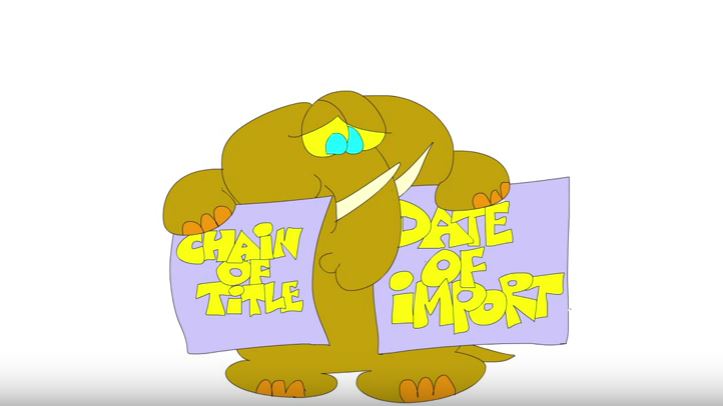Market
VIDEO: Behind the Ivory Curtain
A ban on illegal ivory has far-reaching implications for antiques dealers.

A ban on illegal ivory has far-reaching implications for antiques dealers.

Charles and Thomas Danziger

This year the US Fish and Wildlife Service imposed a sweeping ban on the import and sale of ivory from the African elephant, an endangered species that has been decimated due to poaching. Now, the import of African elephant ivory for commercial purposes, meaning for buying and selling, is banned. The ivory can be owned, but not legally sold.
The ban also applies to the sale of antiques containing ivory, except for certain items 100 years or older that were either created in the United States or imported prior to September 22, 1982.
This means that trade in works less than 100 years old—such as Art Deco pieces from the 1920s and 1930s—is now effectively banned.
The upshot of the prohibition is that today even much ivory that was legitimately purchased and legally imported decades ago cannot be legally sold. Importers and sellers of works whose sale is not prohibited must now be prepared to provide documentation that exempts them from the prohibitions.
This can be challenging, to say the least, if you have just inherited grandpa’s ivory chess set or if you want to sell dad’s ivory tusk letter opener.
Before the ban went into effect, the burden of proof was on the government, not the seller, to prove that someone knowingly sold illegal ivory. That made prosecution difficult and rarely pursued. Now the burden of proof has been shifted to the person claiming the exemption.
How does banning commercial use of antiques help African elephants? The government says that it’s extremely difficult to distinguish between legally acquired ivory and ivory derived from poaching, so blanket restrictions will make it harder to launder illegal ivory into the market.
It is also now illegal to buy or sell ivory within a state, or between states, unless you have documentation that the ivory was taken from the wild before 1976 and lawfully imported into the US before 1990.
You can still own legally acquired works that contain ivory, and you can travel with them for non-commercial purposes across state lines.
The ban was revised to allow for so-called “common sense” adjustments. For instance, museums may import carved African elephant ivory (but not raw ivory) for exhibition and not intended for sale.
The revisions also allow musical instruments made of African elephant ivory to be moved internationally, but not sold, so that musicians using antique instruments that contain ivory can travel with their instruments. Examples of such instruments are bagpipes with ivory fittings, string instruments with bows made with ivory pieces, and pianos with ivory keys. Even so, musicians will no longer be permitted to sell these instruments.
Supporters of the ban say a change was necessary since the US is the second largest marketplace for ivory after China.
Critics of the ban call it the “ivory curtain.”
They claim that owners of ivory, including collectors, dealers and auction houses, are being treated as criminals. They regard the ban as unconstitutionally depriving them of their property without due process. They call the ban “legalized theft” of their property, and they say the poachers should be penalized, not collectors who have followed the rules.
As for the background to the prohibition, the US has, since 1975, been part of the Convention on the International Trade in Endangered Species in order to combat poaching of endangered species. Each country has to pass it own laws to implement the treaty. But US laws on ivory have been routinely criticized as being full of loopholes.
Recently the US decided it needed to do more to reduce its involvement in illegal wildlife trafficking. In fact, in November of 2013, to kick off its new campaign, the Fish and Wildlife Service crushed almost six tons of seized illegal ivory.
And in 2012, the Fish and Wildlife Service seized over $2 million of illegal elephant ivory from two retail stores in Manhattan that were claiming to be selling only antique or other legal ivory.
Recently New York State—the largest importer of ivory in the US—banned the sale of elephant ivory except for antiques composed of less than 20 percent ivory.
The federal ban will not affect ivory derived from other species, such as walrus, warthog, hippopotamus, mammoth, and mastodon. This means that, when buying ivory, you should get an appraisal that describes the type of ivory you are purchasing.
You should also get documentation that shows the chain of title and the date of import.
Of course, the rules could still change since the ban is an administrative pronouncement and not a legislative enactment. In the next few months, expect regulations from the Fish and Wildlife Service explaining how the rules will be implemented.
If you import or sell ivory illegally or make false documents, you could be subject to large fines. If you traffic in ivory, you could be subject to a prison term of up to five years.
Charles and Thomas Danziger, partners in Danziger, Danziger & Muro, LLP, are New York–based art lawyers who represent collectors, dealers, banks, auction houses, and others in the art community. For more information, visit www.danziger.com. Their column “On The Case” will appear periodically on artnet News. Nothing in this article is intended to provide specific legal advice.